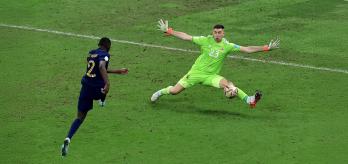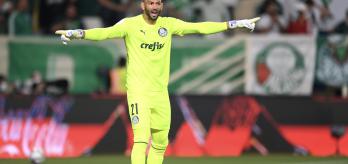Introduction
There are many factors in a game that impact the decision-making process for goalkeepers. As the ball travels towards their penalty area, these change. When the goalkeeper's team is in possession, attacking in the opposition's final third, the goalkeeper's position in relation to their last line of defence is vital.
The goalkeeper has a responsibility at this stage of the game to ensure that they are communicating and organising the players in front of them and that they have a structured defence that can deal with and nullify any potential counter-attack should their team lose the ball and have to transition into defence.
These factors include:
-
the location of the ball and who is in possession;
-
the team's ability to put pressure on the ball or slow the attack down when a transition into defence occurs;
-
the number of defenders v. the number of attackers; and
-
the body shape of their defenders in relation to the position of the attackers.
The goalkeeper needs to constantly assess when and where their biggest opportunity will be to stop an opposition attack and prevent them from scoring a goal.
Goalkeeper positioning in transition at the FIFA Club World Cup UAE 2021™
During the FIFA Club World Cup UAE 2021™, our Technical Study Group identified some examples of different approaches to these types of situations, particularly by Édouard Mendy (Chelsea) and Esteban Andrada (Monterrey).
In this article, we analyse the decisions made and positions taken up by these two goalkeepers during the moments leading up to a transition into defence and the factors that impacted their decision-making processes as the ball approached their penalty area.
ÉDOUARD MENDY (Chelsea)
Chelsea goalkeeper Édouard Mendy tended to adopt a high position when his team was attacking in the final third. By taking up an advanced position, Mendy was able to cover his defenders and see when the situation was in their favour, enabling him to adjust accordingly.
Example 1
According to Pascal Zuberbühler, "Mendy was able to dominate the space behind his high defensive line, but he also recognised when his defenders had a numerical advantage and made impactful decisions, choosing when to commit and when to drop off".
Dropping back allowed Mendy to take up a good position to deal with the next phase of the attack. When the ball was played wide to the additional player joining the attack, Mendy was already set and in the perfect position to deal with the next phase of play.
Example 2
In the above situation, Mendy demonstrated excellent decision-making ability when the circumstances favoured his defenders to deal with the situation, but his behaviour and actions were different when he saw that an attacker had the upper hand over his defenders.
When the opponent got in behind the last line, Mendy narrowed the angle by getting closer to the attacker and deciding whether to challenge for the ball, rather than exposing his defenders to a potentially riskier challenge.
As we can see below, as the attack approached the Chelsea penalty box, Mendy chose to hold his advanced position as his defender was in a dangerous 1v1 situation with the attacker goalside in the central channel, and a challenge could be risky.
When put under pressure, the attacker took a loose touch, giving Mendy the opportunity to advance for the ball. His initial advanced position allowed him to capitalise on the loose touch in a split second.
ESTEBAN ANDRADA (MONTERREY)
Monterrey goalkeeper Esteban Andrada also dominated his whole penalty area from the edge of the six-yard box. Aggressive and brave in his approach, Andrada was never afraid to bear down on strikers to narrow the angle.
Andrada's advanced starting position allowed him to react quickly and respond to the attacking player's moves. A deeper initial starting position would have increased the shooting opportunities for the attacker and give the opposition an advantage.
Footwork - the crucial first step
Another major part of Andrada's game is his ability to constantly be on move and adjust his position as an attack develops. During these moments, the goalkeeper's first step is crucial. If the ball is approaching on the right side, the goalkeeper's first step must be with their right foot. If it is down the left side, it must be the left foot.
Taking the correct first step gives the goalkeeper a potentially vital extra second to react or respond to a situation. In Andrada's case, when his defensive line is not set to defend attacks from out wide, he advances to command the space.
When the ball was switched from one side of the pitch to the other, Andrada's footwork is swift and assured, allowing him to take up a position at his near post. By taking his first step with the correct foot, he has time to adjust.
Positional agility and reading the game
As the attack develops on his right, his position leaves the near post open enough so that he can cover danger in that area, but also allows him to adjust to an attack down the middle and to be set for any shots from that area.
According to Zuberbühler, "This ability to switch from goal defending to zonal defending is so impressive. Many goalkeepers can have a good position at one point, but when the point of attack changes, they can't always adjust well to the next situation. Andrada does this brilliantly, however. He can switch from one situation to the next very quickly, which makes him stand out."
Zuberbühler also noted Andrada's positional agility and his impeccable reading of situations. "It was impressive to watch Andrada and see how he coped when his starting position was out of his comfort zone. He didn't just defend the goal, but his whole penalty area, and he had a really clear relationship with his defensive line. He was brilliant."
Principles of attacking goalkeeping
Both Mendy and Andrada are goalkeepers who dominate their penalty area from advanced positions. Their ability to do this enables them to make better decisions and to execute them faster.
The key factors in attacking goalkeeping are:
-
taking up an advanced starting position;
-
recognising which team has the numerical advantage;
-
assessing the body shape of the defenders in relation to the position of the attackers; and
-
taking the correct first step to adjust to a change in the position of the attack.

















